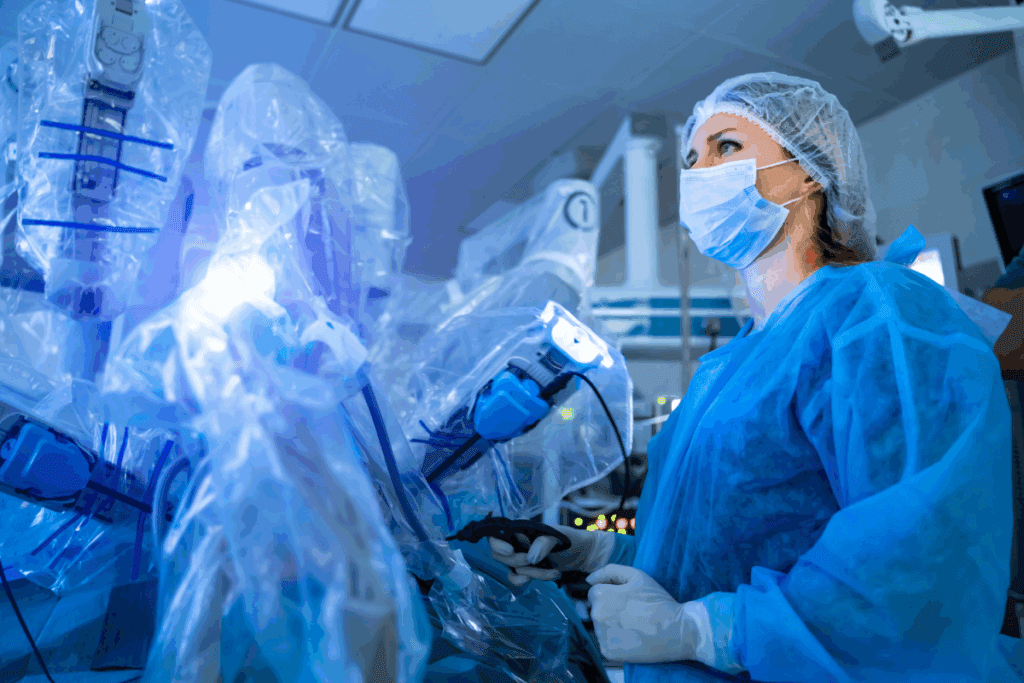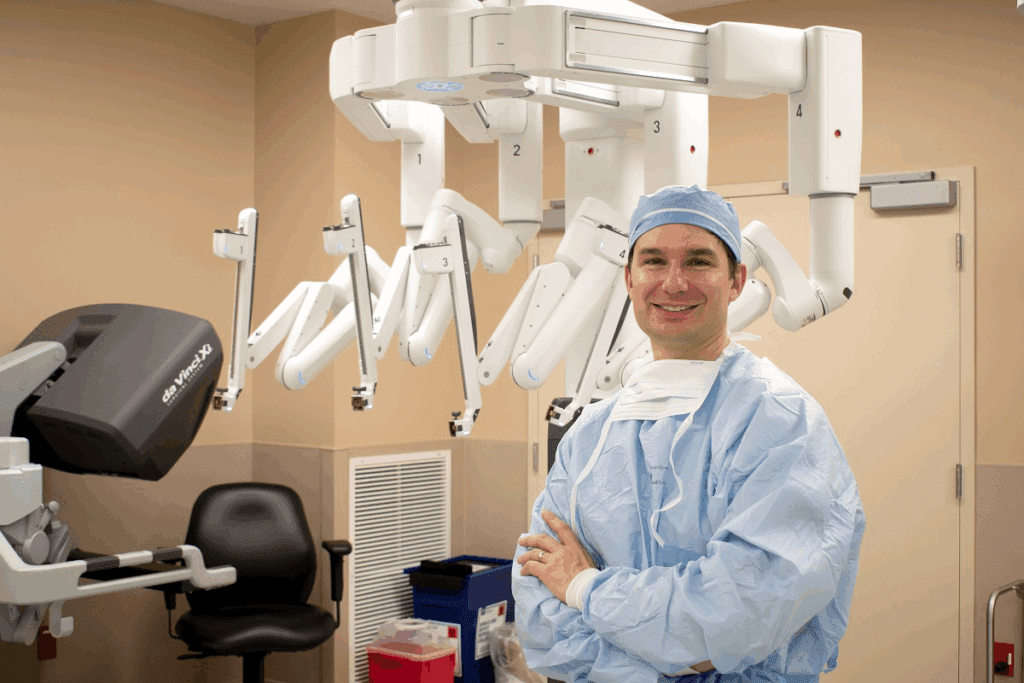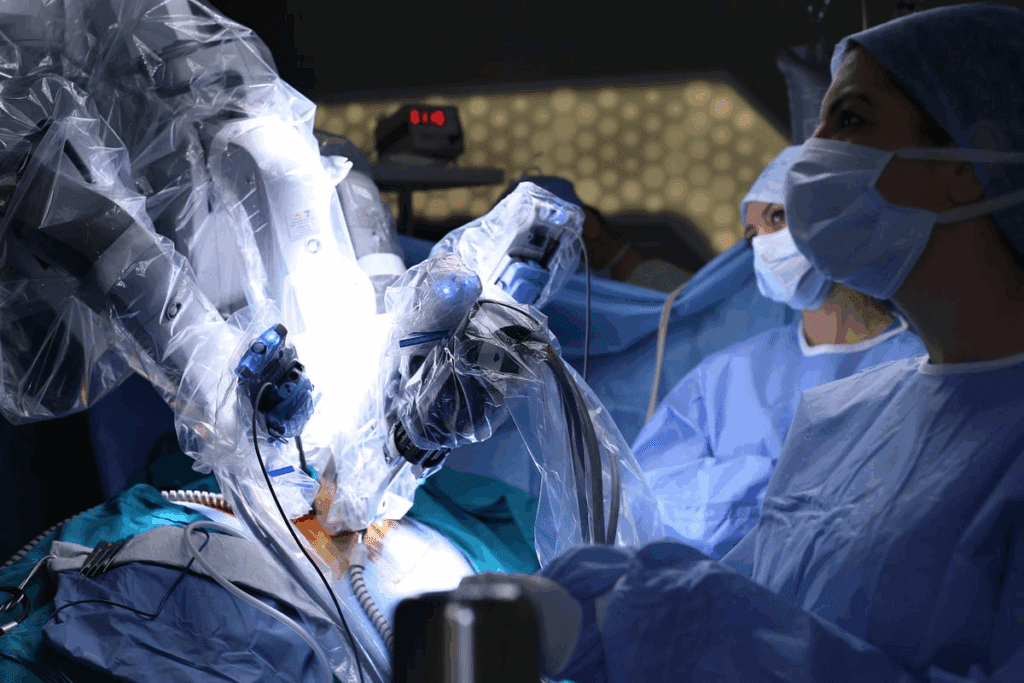Last Updated on November 27, 2025 by Bilal Hasdemir

Nearly 800,000 hernia repair surgeries happen every year in the United States. A big part of these use robotic-assisted techniques. As robotic hernia surgery becomes more common, we need to know more about its safety and benefits.
The use of robotics in hernia repair has changed the game. It brings better precision and might lead to fewer problems. But, there are questions about the safety and how well it works.

Robotic-assisted surgery in hernia repair is a big step forward. It makes surgeries more precise and flexible. This could lead to better results for patients.
Robotic-assisted hernia surgery uses a robotic system for hernia repair. It lets surgeons do complex tasks with better precision and dexterity. The system has a console for the surgeon, robotic arms for the patient, and a 3D vision system.
The high-definition 3D visualization helps surgeons see the area clearly. This is key for the detailed work needed in hernia surgery.
Hernia repair methods have changed a lot. We’ve moved from open surgery to laparoscopic and now robotic-assisted surgery. This change aims to reduce recovery time, pain, and improve results.
In hernia surgery, robotic systems give surgeons a user-friendly interface. The surgeon’s actions at the console control the robotic instruments. This allows for delicate tissue handling and accurate mesh placement.
The robotic system also filters out hand tremors. This makes it great for doing complex tasks in tight spaces during hernia repairs.

Robotic technology has made it easier for surgeons to treat various hernias. This includes inguinal, ventral, incisional, and hiatal hernias. Robotic surgery brings better precision, less scarring, and quicker healing.
Inguinal hernias happen when part of the intestine bulges through a weak spot in the abdominal muscles. Robotic surgery makes small cuts for the robotic arms. This way, the surgeon can fix the hernia with clear 3D views.
Benefits of Robotic Inguinal Hernia Repair:
Ventral hernias are in the abdominal wall, and incisional hernias are through scars. Robotic surgery places mesh with precision. It offers better views and more accurate mesh placement.
The table below shows the differences between traditional and robotic hernia repair.
| Feature | Traditional Hernia Repair | Robotic Hernia Repair |
| Visualization | 2D visualization, limited dexterity | 3D visualization, enhanced dexterity |
| Incision Size | Larger incisions for open surgery | Smaller incisions for minimally invasive surgery |
| Recovery Time | Generally longer recovery | Faster return to normal activities |
Hiatal hernias happen when the stomach bulges into the chest. Robotic surgery does precise dissection and repair. It often includes an anti-reflux procedure for better results.
Robotic technology in hernia repair is a big step forward. It offers better care and quicker healing. As technology improves, more patients will benefit from robotic surgery.
Robotic hernia surgery is becoming more common. It’s known for its benefits, like quicker recovery times and better results. But, like any surgery, it has its own safety concerns.
Many studies have looked into the safety of robotic hernia surgery. They focus on complications, how often the surgery needs to be changed, and how well patients recover. Most studies show that robotic surgery has low rates of serious problems, like bowel injury or heavy bleeding, when done by skilled surgeons.
Evidence from Comparative Studies: Some studies compare robotic surgery to traditional methods. They often find that robotic surgery has less blood loss and shorter hospital stays. This makes it safer.
Surgeon training and certification are very important. Surgeons need special training to use the robotic system and handle its challenges. Certification programs make sure surgeons are skilled and knowledgeable in robotic hernia repairs.
Hospitals are key in making robotic hernia surgery safe. They follow strict safety protocols. These include:
By following these protocols, hospitals can reduce risks in robotic hernia surgery. This creates a safe place for patients.
Robotic hernia surgery is a new and better way to fix hernias. It uses advanced robots to make the surgery more precise and effective.
Robotic hernia surgery is very precise. It uses a 3D view to help surgeons see and fix hernias better. This enhanced precision lowers the chance of problems and makes patients do better.
The robots also let surgeons do tricky moves with more control. This is very helpful in surgeries where small mistakes can be big problems.
Robotic hernia surgery means less scarring and less damage to tissues. It uses small cuts, which means less pain and scarring after surgery.
The robots’ tools also cause less harm to tissues. This helps patients heal faster and lowers the chance of problems after surgery. This is good for people who worry about scars or look.
Robotic hernia surgery can lead to better results for patients. It combines precision, less scarring, and less tissue damage. This means patients can recover faster and have fewer problems.
Research shows patients often leave the hospital sooner and get back to their lives faster. This improved recovery profile makes patients’ lives better overall.
Robotic hernia surgery has many benefits. But, it’s important to know the risks and complications. These can affect how well a patient does after surgery.
Robotic hernia surgery can lead to complications like infection and bleeding. Adhesions and injuries to nearby tissues or organs are also possible. Research shows these risks are similar to or a bit lower than other surgery types.
A study in the Journal of Robotic Surgery found a 5.6% complication rate. The most common issues were fluid buildup and trouble with urination.
Some things can make complications more likely in robotic hernia surgery. These include:
Preventing complications in robotic hernia surgery requires a team effort. This includes:
By knowing the risks and taking steps to prevent them, patients and surgeons can achieve the best results in robotic hernia surgery.
Choosing between robotic surgery and traditional methods for hernia repair depends on several factors. These include the type of hernia and the patient’s health. Traditional methods, like open surgery and laparoscopic techniques, have long been used. But robotic surgery is gaining popularity for its benefits in recovery time and outcomes.
Open surgery for hernia repair involves a single incision in the abdomen. It’s a traditional method that’s been around for decades. It’s often chosen for complex hernias because of its simplicity. But, it causes more tissue damage and has a longer recovery time than minimally invasive methods.
Key aspects of open surgery include:
Laparoscopic hernia repair uses small incisions for a camera and instruments. Robotic hernia surgery enhances this with better visualization and precision. The robotic system allows for more detailed repairs, potentially lowering complication risks.
Comparison points between robotic and laparoscopic surgery:
Even with robotic surgery’s advancements, traditional methods are sometimes better. For example, patients with a history of multiple surgeries or significant adhesions might do better with open surgery. The availability of robotic technology and the surgeon’s experience also play a big role in choosing the best method.
Factors influencing the choice of surgical method include:
Knowing the recovery timeline and guidelines after robotic hernia surgery is key. This surgery is less invasive, leading to less damage and quicker healing than traditional surgery.
Recovery times can differ, but most patients follow similar steps. They usually:
Recovery Timeline:
| Timeframe | Expected Recovery Milestones |
| 1-3 Days | Manageable pain levels, gradual increase in mobility |
| 1-2 Weeks | Return to light activities, reduction in pain |
| 3-4 Weeks | Resume more strenuous activities, continued improvement in strength |
It’s vital to follow post-operative care guidelines for a smooth recovery. Patients should:
The time to get back to work and physical activities varies. Desk jobs might allow return in 1-2 weeks. Jobs that require more physical effort might take 3-4 weeks or longer.
It’s important to follow the surgeon’s advice on physical activities. Start slowly to avoid any setbacks.
Choosing robotic hernia surgery needs careful thought. Surgeons look at many factors to see if a patient is right for this new method.
Some patients are perfect for robotic hernia surgery. They have complex or recurrent hernias that need careful fixing. The surgery’s advanced tools help a lot with tricky hernias.
Also, those who’ve had surgery before might find robotic repair helpful. It’s good at working around scar tissue and adhesions. The 3D visualization and articulating instruments make it easier for surgeons.
Robotic hernia surgery is great, but it’s not for everyone. Patients with severe adhesions or many surgeries before might face too much complexity.
Other things to think about include the patient’s health, any infections, and the surgeon’s robotic skills. Some health issues, like severe cardiopulmonary disease, can make surgery riskier.
Before surgery, a detailed check is done to see if a patient is a good fit. This includes looking at medical history, doing a physical exam, and using ultrasound or CT scans.
The surgeon will talk about the patient’s health, the surgery’s risks and benefits, and what to expect after. This careful planning helps patients know what to expect and prepares them for the surgery.
Robotic technology keeps getting better, and it’s important to know how it works for hernia surgery in the long run. This surgery is precise and offers clear views, leading to good results in studies.
One key thing to look at is how often hernias come back after robotic surgery. Studies show robotic repair has low recurrence rates, often better than other methods. For example, a study in the Journal of Robotic Surgery found less than 5% of hernias came back within two years.
This low rate is due to the surgery’s precision and the ability to do complex repairs easily. These factors help the repair last longer.
Robotic hernia surgery also boosts patients’ quality of life. It’s less invasive, leading to less pain and faster recovery than open surgery. Patients can get back to their normal lives sooner.
A study in the journal Hernia showed robotic surgery reduced pain and improved life quality at 6 months. This was better than open surgery.
While robotic surgery is safe, there are possible long-term issues. These include mesh problems, adhesions, and rare cases of nerve issues or chronic pain. Managing these problems often needs a team effort.
Doctors and patients need to talk about the surgery’s benefits and risks. Regular check-ups are key to catching and fixing any problems early.
In summary, robotic hernia surgery has good long-term results, with low recurrence rates and better quality of life. Knowing about possible long-term issues and how to handle them is important for the best outcomes.
The future of hernia repair is being shaped by new tech in robotic surgery. As tech gets better, robotic hernia surgery is getting more advanced. This means better results for patients.
Recently, there have been big steps forward in robotic hernia surgery. Modern systems now have better 3D visualization, more dexterity, and higher precision. These improvements help surgeons do complex tasks more easily and accurately.
One big change is the use of artificial intelligence (AI) in these systems. AI helps with planning before surgery, guiding during it, and care after. This could lead to better results for patients.
New methods and ways of doing things are coming up in robotic hernia surgery. For example, single-site robotic surgery is getting more common. It means fewer cuts and possibly less pain for patients.
Another new idea is using enhanced recovery after surgery (ERAS) protocols with robotic repair. ERAS aims to make care before, during, and after surgery better. This could mean patients recover faster and have fewer problems.
The future of robotic hernia surgery looks bright with more tech and technique improvements. We might see autonomous robotic systems and virtual reality (VR) and augmented reality (AR) in training and surgery.
As these new things come along, it’s key for doctors and healthcare teams to keep up. This way, they can give the best care to patients having robotic hernia surgery.
Getting ready for robotic hernia surgery is important. It makes your surgery and recovery better. Here are key steps to help you prepare.
Finding the right surgeon is a big step. Look for a surgeon with lots of experience in robotic hernia repair. Ask your doctor for suggestions or search online for specialists near you.
Check the surgeon’s credentials, patient feedback, and their robotic surgery experience. A surgeon with a good track record and positive patient reviews can make a big difference.
At your first meeting, ask important questions. This helps you know what to expect from your surgery. Some key questions are:
These questions help you make a good choice and feel sure about your surgeon.
Before surgery, there are steps to take. Listen to your surgeon’s advice closely. They might tell you to:
By following these steps and choosing a skilled surgeon, you can have a successful surgery and a quick recovery.
Robotic hernia surgery is considered a safe and effective option for treating hernias. It offers better precision, less scarring, and less tissue damage. This leads to better results for patients.
Looking at the benefits and risks of robotic hernia surgery is key. It’s important to know about possible complications like hernia coming back. Studies show it’s safe, but training and certification of surgeons are critical to avoid risks.
In summary, robotic hernia surgery is a good choice for those needing hernia repair. With ongoing tech improvements, its future looks bright. It promises better care and results for patients. It’s important for patients to talk to skilled surgeons to find the right treatment for them.
Robotic hernia surgery is safe when done by a skilled surgeon in a good hospital. Studies show it has few complications and improves patient results.
It offers precise surgery, less scarring, and less tissue damage. It also improves how well the surgeon can see and move, leading to better results and quicker recovery.
Robotic surgery can fix many hernias like inguinal, ventral, incisional, and hiatal. The method is chosen based on the patient’s needs and the hernia type.
Robotic surgery has less scarring, less tissue damage, and quicker recovery than traditional surgery. But, the best method depends on the patient and the surgeon’s choice.
Recovery time varies by patient and hernia type. Most can get back to normal in weeks, with full recovery in months.
Like any surgery, robotic hernia surgery has risks like infection and bleeding. But, these are rare and usually manageable with proper care.
Talk to a skilled surgeon to see if robotic surgery is right for you. They’ll check your health and needs to decide.
Expect a detailed medical check, physical exam, and tests to understand your hernia and health.
Follow your surgeon’s advice on pre-op care, like diet, meds, and lifestyle changes.
Outcomes are usually great, with low recurrence rates and better life quality. But, results can vary based on hernia type and health.
Yes, new tech and methods are being developed to improve outcomes, reduce recovery, and make surgery safer and more effective.
Subscribe to our e-newsletter to stay informed about the latest innovations in the world of health and exclusive offers!